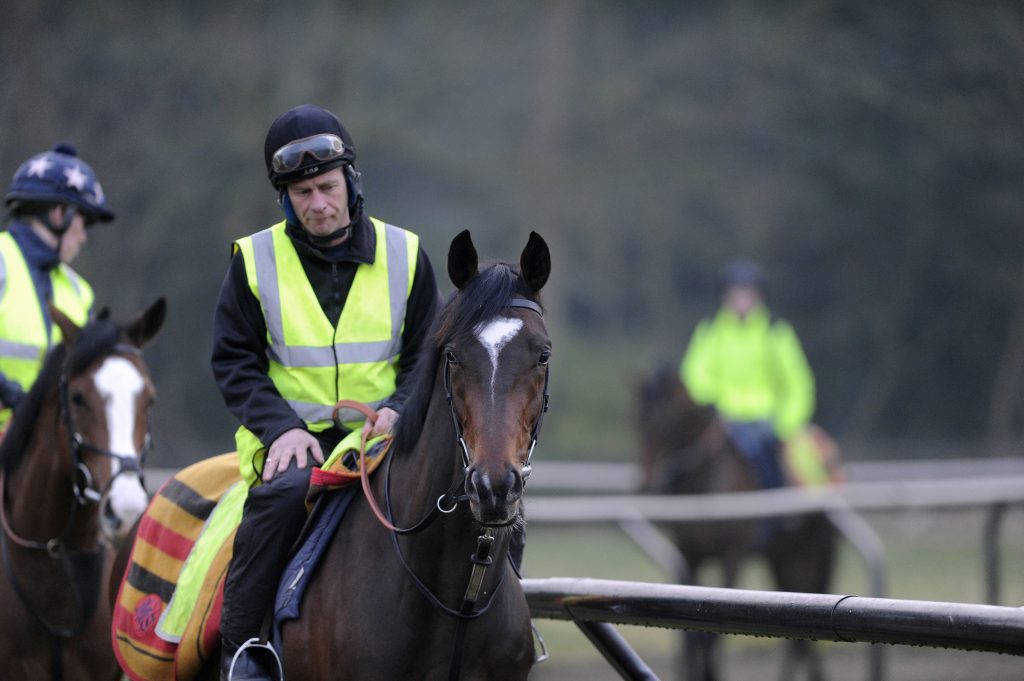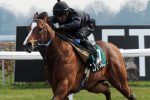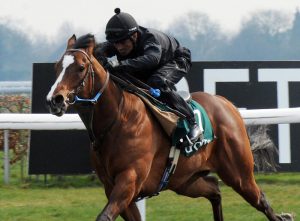Where Highclere Thoroughbred Racing is concerned, the sight of happy owners embracing Harry Herbert in the winner’s enclosure is merely the tip of the iceberg.
It’s the visible residue of much soul-searching, of months spent combing paddocks and sales grounds, and of bidding battles for yearlings that end in joy or despair. Shareholders encouraged to dream big by Highclere’s past exploits are being served by a buying policy refined over 20 years.
John Warren is at the heart of it, as he has been for two decades since Herbert, his brother-in-law, established a venture that has savoured a succession of triumphs at the highest level. Just 12 months ago Highclere had the second favourites for both the Derby (Bonfire) and the Oaks (Vow).
Such achievement vindicates Highclere’s policy when buying yearlings. It is an arduous annual process and last year most of it came to fruition at the Tattersalls Book 1 Yearling Sales in October. Only then was the Warren/Herbert axis able to rest easy.
In 20 days I visited 52 farms and saw every yearling they had; an average of 80 yearlings each day
“We came into the sale having bought one yearling at Doncaster and none at all at Deauville,” Herbert recalls. “That left me in a bit of a state but we have been doing it for a while now. The numbers usually work out in the end.”
Trade at Book 1 was remarkably strong for a catalogue in which individuals matched up to their regal pedigrees. The plan was to catch up with Herbert and Warren when that sale closed, and with buyers finding it hard going, the assumption was that they, too, had been left frustrated.
The assumption turned out to be false. Despite their state of near-exhaustion they wore the look of men who’d done their Christmas shopping in double-quick time and were interested only in bargains at the start of Book 2. They would have been satisfied had they been unable to add to the 11 yearlings they bought at Book 1, but opportunity knocked.
By the day’s end they had added two sons of High Chaparral – at 100,000gns and 80,000gns – that would be paired together in the Ashes syndicate, a new venture with designs on the horses racing in Australia in 2015. “They were two beautiful horses for the money we paid,” Herbert reflects. “We felt they both slipped through the net.”
Those last two purchases marked the culmination of six intense weeks for Warren. The denouement was particularly pleasing, since Warren decided not to attend the American yearling sales in September. That freed up a deal of extra time for him to prepare for the action at Goffs and Tattersalls.
“It meant I could spend an extra three weeks going around stud farms in Britain and Ireland,” he explains. “In 20 days I visited 52 farms and saw every yearling they had. We saw an average of 80 yearlings each day.
“Our biggest issue is time, but seeing the horses on the farms gave us much more time at the sales. We had a good head start and that paid off at the sales because we were able to watch the market and react accordingly, rather than spend most of our time looking at horses.”
Warren has other clients in addition to Highclere. His preparation covers all the various bases, from owners keen to play at all levels from 50,000gns right through to the top end. In 2012 Highclere’s yearlings ranged in price from 60,000gns to the €187,500 given privately for a 75% share in an Invincible Spirit colt that was withdrawn from the auction, and in which his breeder, Lady O’Reilly’s Castlemartin Stud, has retained a quarter-share. Half of Warren’s 22 purchases from Book 1 were for Highclere.
Warren never deviates from a proven formula when buying yearlings. First up, he gets a mental snapshot of the yearling. “It’s a split-second thing, like a photograph going off in your brain,” he says. “That’s why the horse has to stand very correctly, and why I am very fussy about that.”
He then looks at four elements on the catalogue page: birthdate, sire, broodmare sire and the yearling’s female family. “I’m looking to see whether the horse matches up physically with the page,” he says.
“If I’m looking at a Royal Applause out of a Rainbow Quest mare and the horse is a strong, powerful, precocious type, I know he is coming more from Royal Applause. I won’t spend any more time looking at a horse if all these elements don’t align.”
If they do, he advances to the next stage.
“Then it comes down to the horse’s conformation, and finally its action,” he says. “My final decision will be based on a horse’s movement; how it uses itself. And if all that falls into place we move on to the veterinary checks.”
Warren has worked in harness with vet Nick Wingfield Digby for the last 25 years. The latter knows what Warren likes – and more importantly what he is prepared to accept in terms of perceived physical flaws.
They examine the X-rays together: all 36 plates for each yearling, every one of which is also scoped for potential wind issues. Any yearling surviving this meticulous sieving process makes its way onto Warren’s short-list, which numbered around 20 on each of the three days.
Meanwhile, Herbert is holed up in Warren’s office at Tattersalls, where sticky yellow post-it notes adorn the walls under the chosen syndicate names. All but one syndicate is named after former Highclere horses: hence Distinction, Harbinger, Lake Coniston, Petrushka and Alcove, who was Highclere’s inaugural winner in 1993. The exception is the Ashes syndicate, with its Australian overtures.
“The trainers for each syndicate are decided in advance,” Herbert says. “As we buy the yearlings they are allocated to the syndicates,” Herbert says. “If the yearling looks like an extra-sharp two-year-old type it is more likely to go to Richard Hannon than Sir Michael Stoute. We also need variety to satisfy shareholder demand.”
Herbert must also decide on the overall yearling spend with a firm eye on how many shares he believes he can sell. “In 2011 we offered 152 shares but this time we have gone for 162,” he says. “If we sell all of them we will recoup £2.9 million, as opposed to £2.7 million the year before.”
Herbert eventually settled on nine syndicates of two yearlings each, and the process of filling those syndicates is swift. Within days of Tattersalls’ Book 2 sale ending the 18 yearlings are parading before prospective shareholders at Highclere Stud, which is owned jointly by Warren and his wife Carolyn.
Warren has one more responsibility in the share-selling process. Before a gathering of 200 people on each of three days he gives a dissertation on each Highclere yearling. His audience is captivated; you could hear a pin drop on the grass. The address is so detailed that it would enlighten many an aspiring bloodstock agent, never mind the collection of largely thrill-seekers he addresses.
Interspersed with Warren’s professorial delivery is Herbert’s theatrical banter, often in harness with trainers on Highclere’s roster. William Haggas rises to Herbert’s prompting (“John talks about the beam of a horse; I just say arse”), as does Hannon, who reminisces of the time he lined up a punt for Herbert’s late father Lord Carnarvon.
Trainers new to Highclere are introduced: there’s Freddy Head and Marco Botti. The atmosphere is akin to prize-giving at a school that well-heeled parents are proud to patronise, and where headmaster Herbert preaches with near-evangelical zeal of Highclere’s past achievements. And with good reason.
“John’s record as a yearling buyer is key,” he maintains. “We have around 18 syndicates on the go at any one time (each syndicate has a two-year life cycle) and since we started the stats show that six of them will race a black-type horse.”
Once the parade ends the audience descends from temporary stands to mingle with the yearlings and their trainers. Some of the guests were here when Herbert launched Highclere 20 years ago. Around 70% of those who will take up shares in the 2012 offering have done so before.
“This year we sold slightly more than half the shares before we bought our first yearling,” Herbert says. “For some people, the priority is to be with certain trainers – so much so that some syndicates fill before the yearling parade.”
That can lead to disappointment. Malcolm Kimmins, part-owner of Cheltenham Gold Cup hero Bobs Worth and a Highclere regular, wants to join the Lake Coniston syndicate, which has horses with Hannon and Haggas. It is already closed. “I always like to see the hoses parade before choosing,” Kimmins laments.
I’m a reluctant buyer by nature but I’m working with Harry, who is the eternal optimist
Shares have been pitched at prices ranging from £14,500 to £37,950, the latter for the top-end Harbinger syndicate of 12 shares (all the others have 20) embracing the two most expensive yearlings. When asked for a progress report in early March, Herbert proudly announces that all but one of the 162 available shares has been sold.
Could he have been a little bolder with his projections? “Possibly,” he reflects.
“We might have been able to get one more syndicate off the ground, but the risk is high. Any unsold shares go straight onto our bottom line, and shares not sold by Christmas tend to stay with us until the Flat starts in spring.”
It’s a case of mission accomplished and, while Herbert is the seemingly effortless compere, the hectic, share-selling window between August and October leaves him mentally and physically drained.
It helps that Herbert and Warren know each other so well. Each has his own way of working and, while their respective roles are clearly demarked, Herbert is occasionally left bemused. Having coveted a yearling for two months after endless viewings, it’s not uncommon for Warren to get cold feet when the yearling reaches the pre-sales ring.
“I do wonder why he sometimes has a sudden change of heart,” Herbert says of Warren, “but in the end it is always down to John whether we buy or not. He never compromises on selection.”
Warren smiles when prompted about that. “Harry always encourages me not to have those doubts but I’m always a doubter,” he says. “I am a reluctant buyer. By nature I’ll always finds a reason not to buy but I’m working with Harry, who is the ultimate optimist. He will always see the upside.”
Perhaps that explains why this long-standing double-act works so well as a team.
Telescope: ‘Our big hope for 2013’
In 2000 Petrushka became Highclere’s inaugural Classic winner when she made off with the Irish Oaks, to which she later added the Yorkshire Oaks and Prix de l’Opera. And hopes are rising over the Classic prospects of another Highclere graduate in Telescope, who is trained, like Petrushka, by Sir Michael Stoute.
The Galileo colt’s reputation preceded him to Ascot ahead of his debut in September, and although he narrowly failed to make a winning debut he atoned when winning a similar race at Newmarket in clear-cut fashion to earn a prominent position in the ante-post Derby market.
“He is our big hope for 2013,” Herbert says. “Having not seen him for seven weeks, he looked unbelievable when I saw him towards the end of February. Physically he is an awesome-looking horse. He has really progressed and we can’t help but be excited by him.”

Telescope: Highclere’s next big hope – Photo: George Selwyn
Telescope was bought as a yearling for 225,000gns outside the sales ring at Newmarket, when a high temperature obliged him to miss his date with the auctioneer. He has much to prove before he can take his place at Epsom, but he will travel down the Derby trials route.
Telescope thus follows in the hoofprints of Bonfire, who shot to prominence in last year’s Derby betting after winning the Dante Stakes. Bonfire remains in training for Highclere, which also has a new older-horse addition to its portfolio in Rule Book. Now a four-year-old, Rule Book was bought for 230,000gns at last year’s Tattersalls’ horses-in-training sale and was subsequently sent to Gai Waterhouse in Australia.
“Rule Book is in the process of being syndicated by a new Highclere subsidiary in Australia,” Herbert says. “The Australians are interested, and so are owners in Hong Kong.”
Rule Book precedes what Herbert hopes will be the transfer of a pair of two-year-olds by High Chaparral within the Ashes syndicate, currently in training with Stoute and William Haggas, to race in Australia in 2015. “Racing is vibrant out there, as is prize-money for middle-distance types,” Herbert says. “In the meantime, Rule Book will hopefully get us a piece of the action.”
The action flows thick and fast for Highclere these days – and not just on home shores.



